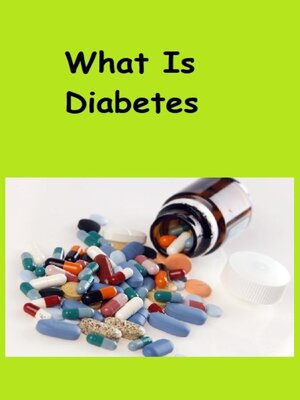
Sign up to save your library
With an OverDrive account, you can save your favorite libraries for at-a-glance information about availability. Find out more about OverDrive accounts.
Find this title in Libby, the library reading app by OverDrive.



Search for a digital library with this title
Title found at these libraries:
| Library Name | Distance |
|---|---|
| Loading... |
diabetes—a chronic condition that affects how your body processes blood sugar (glucose). Let me break it down for you:
What is Diabetes?
Diabetes is a metabolic disorder where the body either doesn't produce enough insulin or can't effectively use the insulin it produces. Insulin is a hormone that helps regulate blood sugar levels. If left unmanaged, high blood sugar can lead to serious health complications.
Types of Diabetes
Type 1 Diabetes
An autoimmune condition where the immune system attacks insulin-producing cells in the pancreas.
Usually diagnosed in childhood or early adulthood.
People with Type 1 diabetes need lifelong insulin therapy.
Type 2 Diabetes
The body becomes resistant to insulin, and the pancreas can't produce enough to keep blood sugar levels normal.
Commonly linked to obesity, poor diet, and lack of exercise.
Can be managed with lifestyle changes, medications, and sometimes insulin.
Gestational Diabetes
Occurs during pregnancy when hormonal changes affect insulin function.
Usually resolves after childbirth but increases the risk of developing Type 2 diabetes later in life.
Prediabetes
Blood sugar levels are higher than normal but not high enough to be classified as diabetes.
A warning sign that diabetes could develop without lifestyle changes.
Symptoms of Diabetes
Increased thirst and frequent urination
Extreme fatigue
Blurred vision
Unexplained weight loss (Type 1)
Slow wound healing
Tingling or numbness in hands/feet (Type 2)
Causes & Risk Factors
Type 1: Genetic predisposition, autoimmune response, environmental triggers (like viruses).
Type 2: Obesity, poor diet, sedentary lifestyle, family history, aging.
Gestational Diabetes: Hormonal changes during pregnancy.
Complications of Uncontrolled Diabetes
Heart disease and stroke
Kidney damage (diabetic nephropathy)
Eye problems (diabetic retinopathy, blindness)
Nerve damage (neuropathy) leading to pain, numbness, or amputation
Skin infections and slow wound healing
Treatment & Management
Type 1 Diabetes
Requires insulin injections or insulin pumps.
Monitoring blood sugar levels regularly.
Healthy diet and exercise to maintain blood sugar balance.
Type 2 Diabetes
Lifestyle changes: weight loss, healthy diet, regular physical activity.
Oral medications (like Metformin) or insulin if necessary.
Regular monitoring of blood glucose levels.
Gestational Diabetes
Controlled with diet, exercise, and sometimes insulin.
Prevention (for Type 2 and Prediabetes)
Maintain a healthy weight.
Eat a balanced diet (low sugar, high fiber, whole foods).
Exercise regularly.
Reduce stress and avoid smoking.







